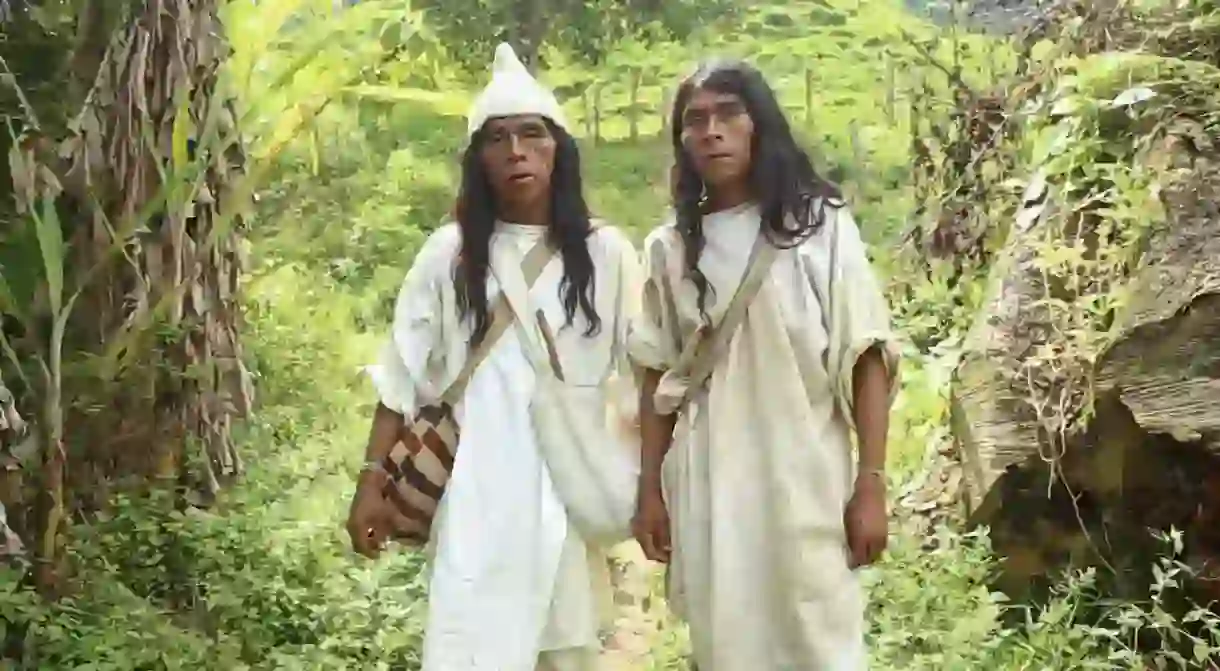The Culture of the Wiwa, an Indigenous Colombian Tribe in the Sierra Nevada

The Wiwa tribe in Colombia’s Sierra Nevada mountains have lived harmoniously with the wildlife surrounding them for thousands of years.
Rising approximately 5,000 meters out of Northern Colombia’s Caribbean shores, the misty, cloud-shrouded Sierra Nevada mountains have been the home to indigenous tribes for more than 2,000 years. As if unaffected by time, the Sierra’s indigenous tribes still live as their Tairona ancestors did centuries ago. Despite growing modernization and tourism in the area, the Wiwa community – the smallest of four tribes living in the Lost City today – show us how they strive to keep their ancient culture alive.
Who are the Wiwa?
The Wiwa are direct descendants of the Tairona people (200 BCE), a great civilization whose impressive skills in architecture and gold work attracted the unwanted attentions of Spanish colonists in the early 16th century. Despite an increase in contact with the outside world, the Wiwa community still rejects modern life. Instead, they choose to live as their ancestors did: off the land and dedicating their lives to connecting spiritually with it. With a population of around 7,000 people, they’re the smallest ethnic group living in the Sierra Nevada mountains today.

What’s the Wiwa community like?
The Wiwa live a simple, community-driven life. Calling themselves the Damanas – the protectors of Mother Nature – the Wiwa dedicate most of their lives to safeguarding the natural world. At the center of the community are the Mamos, or spiritual leaders. Mamos have the responsibility of maintaining order within the community (by leading meetings to discuss important tribe matters) and, most importantly, to maintain the natural orders of the physical and spiritual world through meditation, song, and rituals. Training to be a Mamo starts at a young age and can take up to 18 years to complete.

Why the Sierra Nevada?
To the Wiwa, the Sierra Nevada Mountains are the beating heart of the physical world and a connection into the spiritual realm. Similar to the Andean communities found in Peru and Bolivia, the Wiwa consider Mother Earth to be their goddess. The mist-shrouded peaks, the lush tropical forests, the vast open savannahs – every living and breathing part of the Sierra Nevada is deemed sacred. It is, after all, these mysterious mountains that provide the community with everything needed to survive: food, water, and medicinal herbs. The Wiwa believe it is their life’s work, as it was their ancestors’, to protect and appease the world’s most vital organ.

What role does the coca leaf play?
So, how does one protect and appease this living and breathing goddess that is the Sierra? Through ritualistic offering. The coca leaf – or áyu, as it’s known in the Arhuaca language – plays a central role in the spiritual and ritualistic lives of the Wiwa. The women dedicate their mornings to collecting the sacred coca leaves, after which the men toast them by tossing them in a bag with a hot stone, and then they put them in a small woven bag to carry around wherever they go.

Throughout the day, they’ll put small clusters of coca leaves in the side of their cheek and chew on them. The juice from the leaf not only gives them energy, but it also helps the Wiwa connect and communicate with their surroundings on a deeper level. If a Wiwa meets another tribe member while he is out, they will exchange coca leaves as a sign of respect.
The importance of the Poporo (Danburro)
When the coca leaf is chewed by itself, however, not all of its ingredients are released. The adults, therefore, always carry another very important and sacred object: the Poporo (also called a Danburro), which every Wiwa boy receives at the age of 18 to mark his transition into manhood. The Poporo starts off as a small hollowed out pumpkin with crushed seashells in its center. A wooden stick is used to transfer the seashell powder from the Poporo into the mouth. The result? The highly alkaline shell reacts with the coca leaf in the cheek to stimulate its active ingredients.

But the Poporo isn’t just about practicality; it also serves as an important symbol of maturity, personal growth, and self-knowledge. The surplus shell substance, mixed with saliva and lime, is constantly rubbed on the neck of the Poporo. Over time, what started as a small and fragile gourd becomes a large and strong Poporo. As this sacred object grows, the Wiwa say, so does the owner’s knowledge of the world. Using the Poporo, along with chewing coca, is a tradition believed to span back hundreds – maybe even thousands – of years; it’s a tradition that, in the face of an ever-changing world, keeps the Wiwa connected to their ancestral past.














